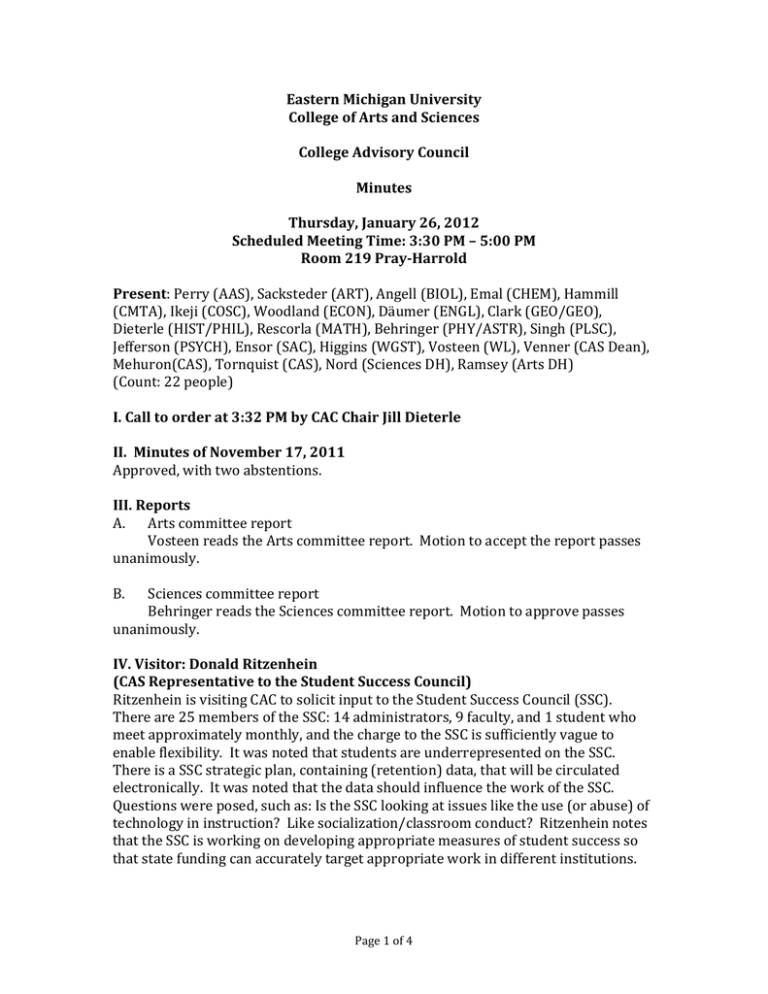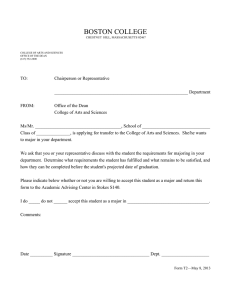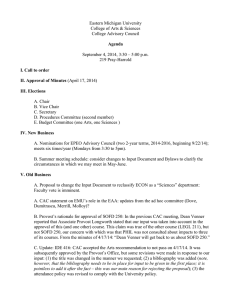Document 13557620
advertisement

Eastern Michigan University College of Arts and Sciences College Advisory Council Minutes Thursday, January 26, 2012 Scheduled Meeting Time: 3:30 PM – 5:00 PM Room 219 Pray-­Harrold Present: Perry (AAS), Sacksteder (ART), Angell (BIOL), Emal (CHEM), Hammill (CMTA), Ikeji (COSC), Woodland (ECON), Däumer (ENGL), Clark (GEO/GEO), Dieterle (HIST/PHIL), Rescorla (MATH), Behringer (PHY/ASTR), Singh (PLSC), Jefferson (PSYCH), Ensor (SAC), Higgins (WGST), Vosteen (WL), Venner (CAS Dean), Mehuron(CAS), Tornquist (CAS), Nord (Sciences DH), Ramsey (Arts DH) (Count: 22 people) I. Call to order at 3:32 PM by CAC Chair Jill Dieterle II. Minutes of November 17, 2011 Approved, with two abstentions. III. Reports A. Arts committee report Vosteen reads the Arts committee report. Motion to accept the report passes unanimously. B. Sciences committee report Behringer reads the Sciences committee report. Motion to approve passes unanimously. IV. Visitor: Donald Ritzenhein (CAS Representative to the Student Success Council) Ritzenhein is visiting CAC to solicit input to the Student Success Council (SSC). There are 25 members of the SSC: 14 administrators, 9 faculty, and 1 student who meet approximately monthly, and the charge to the SSC is sufficiently vague to enable flexibility. It was noted that students are underrepresented on the SSC. There is a SSC strategic plan, containing (retention) data, that will be circulated electronically. It was noted that the data should influence the work of the SSC. Questions were posed, such as: Is the SSC looking at issues like the use (or abuse) of technology in instruction? Like socialization/classroom conduct? Ritzenhein notes that the SSC is working on developing appropriate measures of student success so that state funding can accurately target appropriate work in different institutions. Page 1 of 4 V. New Business A. Dean Evaluation Instrument (NOTE: Dean Venner, the Associate Deans, and the Department Heads stepped out of the room during this discussion.) Dieterle reviewed the history of the development of the current instrument. The evaluation begins with a self-­‐evaluation by the Dean, then the faculty/staff survey. Survey data go to the Dean and to the Provost. The Dean may then respond, and then the Provost responds. (See the CAS College Level Faculty input document at http://www.emich.edu/cas/faculty/pdf/cac/input_doc_20110908.pdf.) CAC representatives are asked to take the draft of this evaluation instrument to their Departments for feedback so that the CAC can vote on this during its next meeting. Please forward the input to Dieterle so that she can prepare a summary of input in advance of the next meeting. A suggestion was made to tag data by particular characteristics, e.g., gender, department, etc., so that analysis can be done to tease out trends. Implementing such a suggestion potentially fairly complicated, so representatives are asked to bring this suggestion to their departments. Ensor volunteered to ask his colleagues in Sociology for advice on designing the survey. B. Instructional Budgets/Workload Issues Wade Tornquist reviewed the way department budgets were constructed in the past, and explains how the budgets are currently constructed (since Fall 2011). Specifically, the current method involves two quantities: the number of FTELs (Full Time Equivalent Lecturers) and the number of student credit hours (SCH). The Dean’s Office assigns to each department a number of FTELs, which essentially sets the number of courses because 1 FTEL = 10 3-­‐credit hour courses (i.e., a full time lecturer teaches 5 3-­‐credit courses each semester, or 10 courses each academic year). Note that one 3-­‐credit hour course is 0.1 FTEL. Note also that a full time faculty member counts as 0.8 FTEL because faculty workload is equivalent to 8 3-­‐ credit courses each academic year. [So using lecturers to deliver courses is, in various ways, favored. Note that this system for workload determination does not assign value to products of faculty work apart from classroom teaching.] The Dean’s Office also assigns to each department a goal for the number of student credit hours (SCH), based on a weighted average of the recent few years of SCH production, with the most recent years weighted more heavily. The only requirement is that the DH achieves the SCH goal using no more than the available FTEL. Consequently, details about low enrollment courses are no longer relevant, and DHs have flexibility in determining course mix and work load It was noted that cross-­‐listed/interdisciplinary courses with multiple instructors have SCH and FTEL divided according to enrollment in the course. For example, if Page 2 of 4 two-­‐thirds of the SCH were generated by philosophy majors, then two-­‐thirds of the FTEL for the course would accrue to the philosophy instructor. CE courses are not counted in this scheme if they are taught outside Washtenaw County. If taught online, it counts as within the Washtenaw County. One idea that the Dean’s Office has is to keep the FTEL if you have extra at the end of the year, i.e., rollover the FTEL credit. This encourages DHs to manage workload better and ‘offload’ costs to entities that are not CAS. VI. Dean’s remarks The Dean notes that we have a new provost, Provost Kim Schatzel. Forums have been held to introduce the Provost to the campus. These forums have been lightly attended but have had high quality discussion. The department heads (DHs) have all met the Provost. The Dean has already started to work closely with the Provost. There are four major items that the Dean is working on during the remainder of the academic year. The first is the successor to the Program Review process to decide whether to phase-­‐out, maintain, or enhance programs. DHs have given input on the latest version of this process and the Dean will want input from CAC on this when it is ready to present to the faculty. The second major item is advising. Recall the advising plan that Diane Winder presented at the last CAC meeting; discussion of advising will be ongoing. The Dean leans toward a centralized support structure without moving the actual advising to a central location. The division of labor between professional advisors and faculty advisors has to be determined. For example, career advising may be best done in the Departments. The third major item is strategic planning. The strategic planning process is moving forward (the Dean noted the recent input from the CAC regarding mission and goals); the strategic plan has been refined and it is going through the final survey process. The fourth major item is faculty hiring. Only 9 faculty hires were allowed this year because of concerns about the budget. Departments should now be working on their proposals for faculty positions. The Dean advises us to “Follow the matrix.” Finally, the Dean is developing a list of capital improvements (e.g., HVAC, roof repairs, electric service…). He encourages input regarding such improvements. VII. Chair’s remarks None. VIII. Faculty remarks None. Page 3 of 4 IX. Adjournment Meeting was adjourned at 4:57 PM. Respectfully submitted, Ernie Behringer 2011-­‐2012 CAC Secretary Page 4 of 4

